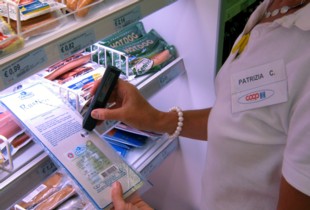Every year, the Texas A&M Transportation Institute releases an oft-cited (and
oft-critiqued)
Urban Mobility Report that measures congestion on American roads, famously ranking the metros with
the most heinous traffic. The report homes in on a central cost of mobility: the price we pay to sit in gridlock.
It does not, however, look much at the value we get for paying that cost: access to wherever we're trying to go.
"When we think about this as economists, we know that every trip that is made is worth it – the value outweighs the cost of taking it – or it wouldn't have happened," says Andrew Owen, the director of the recently created
Accessibility Observatory at the University of Minnesota. "It's a little bit disingenuous to use metrics that only talk about the cost of travel."
Consider a metric – or a map – that captures value instead. Not: How long will it take me to reach my office? But: How many jobs can I reach in half an hour? How many grocery stores are accessible by car within five minutes? Which neighborhoods in town enable the greatest accessibility, by public transit, to really good restaurants?
"We’re interested in looking at how well transportation systems connect people to the things they want to reach," Owen says, "not just how well they let people move around in space."
What would that look like? For starters, this map of the Minneapolis/St. Paul region, created by the Accessibility Observatory:
 Accessibility Observatory
Accessibility Observatory

It looks a bit like an
isochrone, a map showing how far you can travel on a transportation network in a given time frame, starting from a single location. But this map tells us something about every point of origin in the Minneapolis/St. Paul region simultaneously. Specifically, it tells us how many jobs are accessible within 30 minutes – using the key at right – from each location by public transit, during the 7-9 a.m. peak morning window. The darker green areas have the greatest accessibility to jobs; the lighter green areas have the least. The red lines show transit routes.
Bear with me while I explain how all of this information is possible to convey in one picture. This map is built with three key datasets:
GTFS data from the local transit agency tracking when and how often buses and trains run, and where riders might transfer between them (this data didn't exist a few years ago);
OpenStreetMap data on pedestrian routes and walking times needed to reach the nearest transit stop, or to reach an office on the other end of a bus ride (this data also didn't exist a few years ago); and block-level
job counts from the Census Bureau. Those numbers are technically estimates at the block level (for disclosure reasons), but they scale up to accurate, actual numbers at larger geographies.
The Minneapolis/St. Paul region shown here has 54,000 census blocks. The Accessibility Observatory created
a shortest-path tree for every one of them. Given realistic pedestrian access, and actual transit headways and routes, this map reflects every potential path to a job that's possible, within 30 minutes, from every single block group. Similar calculations could be made with car travel, but the Accessibility Observatory hasn't gotten that far yet.
In the Minneapolis/St. Paul region, this travel-time matrix effectively contains 2.9 billion points of data, for every single minute of departure. Your travel options are different, however, if you leave the house at the height of rush hour than if you travel during off-peak service. In fact, depending on when your bus runs, your 30-minute travel map may look different at 7:01 and 7:10 and 7:59. The above map above spans the morning peak from 7 a.m. to 9 a.m. This means it portrays service averaged across 2.9 billion points of data in 120 different scenarios (for each minute from 7-9 a.m.).
To capture a city's picture of transit accessibility to jobs over an entire day (don't forget the night workers!), you'd need to draw those same 54,000 shortest-tree paths for 1,440 minutes. In Minneapolis, that means the Accessibility Observatory – or, rather, the computers it hires from Amazon – processed 4.2 trillion points of data. With it, Owen could now show you a map of 30-minute job accessibility during a different window, from say 4-6 p.m., or he could show you the jobs that are reachable within 15 minutes instead.
"I sometimes still don’t believe it’s actually possible," he says. "Then the data comes back, and I think 'oh, right, computers!'"
This data is also capable of illustrating how much accessibility to jobs varies across time, from a single location. On some street corners, the bus comes every few minutes, and your accessibility looks about the same whether you leave the house at 7:05 a.m. or 8:45 a.m. In other places, the bus runs only every 30 minutes or so, meaning that your accessibility fluctuates significantly, as in
this neighborhood charted by Owen below:
Turn that variable into yet another map, and this next picture shows variation in accessibility to jobs across the region. The palest areas have the most consistent service (and access to jobs), the dark brown areas have the least. Not surprisingly, if you live in downtown Minneapolis, at the center of a hub-and-spoke transit system, your access to jobs is consistently good throughout the 7-9 a.m. window:
The Accessibility Observatory's goal is to repeat this data-crunching process in metros all over the country (a task primarily limited by cloud computing time and the money needed to buy it). Owen would ultimately like to create a kind of comprehensive, annual accessibility report that would mirror the Texas Transportation Institute's Mobility Report. As with congestion metrics, the data would need constant updating, both as transit service changes, and as the locations of jobs shift, too.
Such information could be potentially useful in ways that Owen hasn't even thought of yet (he's hoping researchers of other kinds will knock on his door). Maps like the first one above could help you make smarter decisions about where it live. It could be layered with socio-economic data about a city, more clearly revealing the opportunities for job access in low-income neighborhoods. It could be used to track changes in transit service over time, or to predict the disruptions that could come from future changes.
In the below map, for instance, Owen has calculated the change in accessibility to jobs, during the same 7-9 a.m. window, between 2010 and 2013. The dark green areas have access to 100 percent more jobs in 2013 than in 2010 (dark brown areas lost the most access). The yellow arrow points to a region where bus frequency was significantly increased along a particular line. The red arrow highlights a corridor with a new BRT line, with major improvements to job access right around a single station.
In this fourth map, Owen simulated what would happen to job access if the No. 6 bus were simply eliminated on the southwest side of Minneapolis (holding all else equal in town):
With such manipulations, this tool could help agencies make smarter decisions about how to improve transit for particular neighborhoods, or where to plan new housing, or how to navigate painful budget cuts.
"I hope that’s not the reason someone has to use this," Owen says of that last scenario. "But if it helps them weather a budget cut in a way that impacts communities the least, we’d be really happy with that."
From here, it's intriguing to imagine changing out many of these variables: What would access look like, for instance, to top-rated public schools?
 Dans le cadre de l’expérimentation de l’Affichage environnemental européen (voir ebonus du 23 avril 13), le JRC–Centre de recherche européen vient de publier le Protocole ENVIFOOD édité par la Food Consumption and Production (SCP) qui élabore des directives spécifiques pour l'évaluation de l'impact environnemental des produits alimentaires et boissons tout au long de leur cycle de vie. Le Protocole est présenté comme une donnée stratégique pour les entreprises et la politique européenne du point de vue de la performance économique et environnementale.
Dans le cadre de l’expérimentation de l’Affichage environnemental européen (voir ebonus du 23 avril 13), le JRC–Centre de recherche européen vient de publier le Protocole ENVIFOOD édité par la Food Consumption and Production (SCP) qui élabore des directives spécifiques pour l'évaluation de l'impact environnemental des produits alimentaires et boissons tout au long de leur cycle de vie. Le Protocole est présenté comme une donnée stratégique pour les entreprises et la politique européenne du point de vue de la performance économique et environnementale.

 l’aspetto e la sicurezza.
l’aspetto e la sicurezza.
 Line, featuring a new dual-core hardware platform for greater speed and computing power, and third-party application displays for flexible and customized retail processes from select METTLER TOLEDO partners, according to a company news release.
Line, featuring a new dual-core hardware platform for greater speed and computing power, and third-party application displays for flexible and customized retail processes from select METTLER TOLEDO partners, according to a company news release.

 It looks a bit like an
It looks a bit like an 


